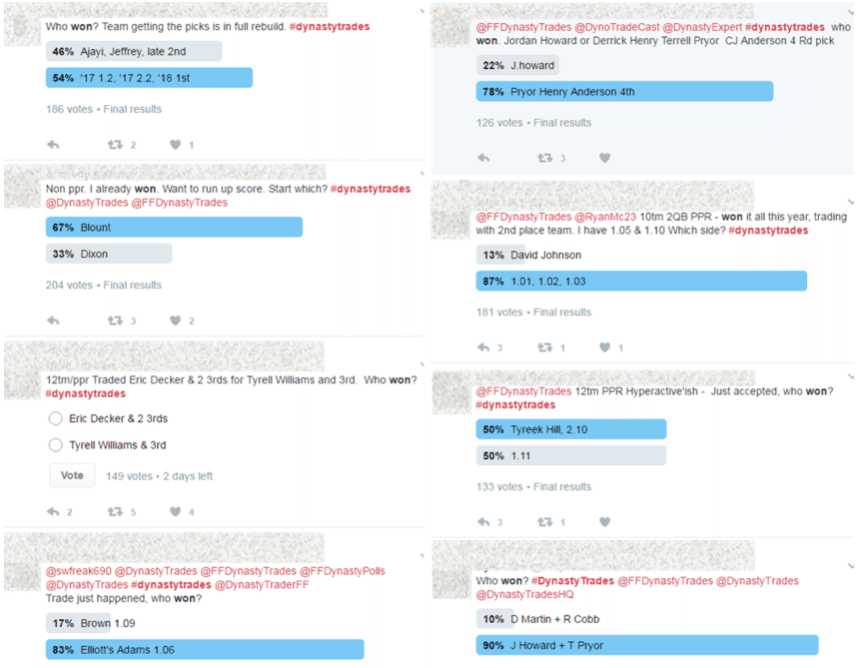Dynasty Trading and Insult Pricing
I went to my local grocery store recently and noticed all the yellow tags and coupons. Largely, it was for discounted items I didn’t need. Meanwhile, much of what I actually want never goes on sale, sitting there with that bland white price tag, mocking me. We have been trained to shop the bargains, loading up on these items in the hope that “Pumpkin Mango Chile Salsa” actually tastes good (it doesn’t).
If the trade block in a dynasty league is the $4 DVD bin filled with Steven Seagal recent releases, then the message board expressing a “player is available” is your yellow tag. It could fit in your pantry and you might even try it, but chances are, you’re going to probably give it to someone else. Instead, we should focus on those everyday prices. The pantry staples that everyone wants but is rarely sold for a discount.
This sounds good except the motivation for many dynasty owners when trading is flawed. It should be about improving your team, not “winning” a trade. The latter has become a more prevalent mindset with the use of social media, and more recently, the functionality of voting. Just searching on Twitter revealed how common this thought process really is.

While maybe in the short-term, making a trade that is an immediate “win” sounds good, but there are major risks to this trade strategy. It also elicits a mindset of making offers that are not only below fair market value, but also offensive to the trade partner. This is where the idea of insult pricing arises.
Every item has a price point that is optimal for both buyers and sellers. That is the fair market value. There is also a price where the other party abandons the transaction and looks for a substitutable product. That is the insult price point. Insult pricing does not simply impact the item in question. For example, if an owner with Odell Beckham Jr. asks for Mike Evans and three first round picks, the Evans owner would likely sever trade talks, perhaps with a nasty message. Additionally, the Evans owner might assume that the Odell owner is typically overvaluing his prospects, thus creating insult pricing but also an insult brand.
So what is the issue with the latter point? Well, let’s talk about the infrequency of dynasty trading (contrary to popular belief) and how losing a trade partner can be impactful.
Thinking about this lately relative to roster construction. How many trades do you execute annually per dynasty league (guess)?
— George Kritikos (@RotoHack) December 16, 2016
Looking at my very scientific poll above, over 75% of owners believe they execute less than six trades per year. Extrapolating these numbers out to an entire 12 team league, it means that there are roughly 28 trades executed per year with the most active three owners representing roughly half (27/56) of the trade partners in these transactions. If we go a step further and believe that you improve your team by 1% with every trade and that represents an increased probability to win each week, then it takes four trades to gain 0.5 wins in a typical league. That doesn’t seem like much, but considering it takes most leagues 7-8 wins for a playoff spot, it increases your odds 6-7% to meet that threshold.
So let’s circle back to insult pricing. We have now established the benefits of being a fair value trade partner and the detriments of being known as an insult price owner. However, one of the biggest questions surrounds what it takes to go from the range of fair value to that of an insult price owner. If you believe the research done in the retail environment, most medium sized competitors stick within 5% of the market leader. They cannot afford to discount a price as low as the big player (like Amazon or Walmart) but try and stay close enough where it is competitive and keeps nearly every customer engaged to their total product selection.
The clear difference, though, is that I can walk into a store and see what they charge for eggs and the currency is consistent. With dynasty trading, it is anything but. You can use new DLF feature The Dynasty Trade Finder to gauge prices for trade targets. There are rankings, ADP, trade calculators, and Twitter polls that all can help you define fair market value.
One more tool can help you avoid the detriments of insult pricing: good faith. The idea of nickel and diming trade partners to the tune of “let me see if he will throw in a fourth” may seem shrewd, but routinely makes you a last resort trade partner rather than a preferred destination. Just remember, winning a championship is a whole lot sweeter (and more lucrative) than winning a trade.
- Bowl Game Previews: CFB Playoff Semifinals - December 28, 2018
- The Narrative Fallacy and How it Compels Us - May 13, 2017
- 2017 NFL Draft – College Wide Receiver AIR - April 27, 2017

































































